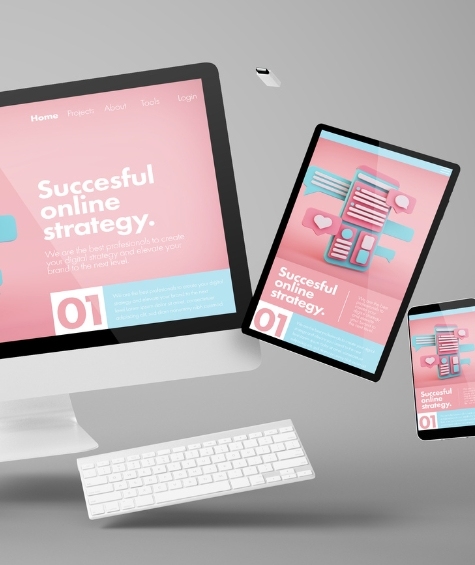One of the first things all therapists need when trying to attract new clients is a professional-looking, user-friendly website. For many people, your website is their first interaction with your practice, and that makes it a crucial element of building trust. A good, user-friendly site not only helps build trust but also helps your clients easily find you and get in touch with you.
Your website should not just be another landing page; it should be an extension of the care and professionalism you put into your practice. Every aspect of your website, from soothing aesthetics to functionality and SEO, will help draw in potential clients and keep them there.
Websterz Technologies specializes in building responsive, custom-built, and conversion-focused website designs for therapists and mental health professionals. Why pass this up with a website that does not do your practice justice and encourage clients to engage with you?

A website is not only your online presence but also your virtual office. The majority of clients start their therapist search online. If your website is not well-designed, potential clients might leave before learning more about you. Your website can-
A professional and engaging website for therapists can turn visitors into clients by leaving a lasting impression and guiding them toward taking action.
Also Read- Why Every Therapist Needs a Website
Mental health awareness has risen significantly in the last few years, leading to an increasing number of people accessing therapy & counselling services. With the increase in demand for therapists, counselors, and mental health professionals comes the need for a robust online presence.
Today, people search for services on their smartphones and laptops—including mental health support. That is why having a well-designed private practice therapist website is essential for attracting clients and growing your practice in today’s digital world.
This is where website usability comes in. A user-friendly, intuitive design plays an important role in building trust, improving engagement, and turning visitors into clients.
When we build a therapist’s website, we are not simply assembling a digital storefront. It is often the first step in someone’s healing journey. Therapy seekers are looking for a warm sense of trust and professionalism to come through in the way your website is designed and presented. You can design a site around these critical points, which makes you more approachable to potential customers. Let’s look at the key elements that each therapist website should invest in-
Did You Ever Visit A Website And Have No Idea What To Click Next? Unclear navigation can lead to frustration and send away visitors. For a therapist’s website, keeping your navigation simple and logical is absolutely essential.
Your navigation menu should be clear, for example: Home, About, Services, Contact. Visitors need to be able to find the information they need without searching for it. If someone is already feeling overwhelmed and anxious, making their experience as easy and stress-free as possible is a great way of showing them that their time and emotions matter to you.
Your words matter. Visitors should feel seen, heard, and understood from the content on your site. Therapy is intimidating for some; using warm, empathetic language helps bring down that barrier.
Pretend you are talking to your clients. Use conversational, easy-to-understand, and soothing language, not clinical, academic, or distant. If your service is cognitive behavioural therapy for anxiety, say, “We support people with anxiety to find peace using methods like CBT” instead.
What is the point of a beautiful website if no one finds it? Search engine optimisation, or SEO, ensures that your site appears in search results when potential clients are looking for answers. For therapists, search terms such as “Best Website Design for Therapists” or “Therapists Near Me” are crucial to optimize your website and can make all the difference in putting you in the path of new clients.
You can also read our post on SEO Benefits Of Responsive Web Design
You can begin by adding relevant keywords in appropriate places on your site, such as headings, page titles, and descriptions. If your specialization is couples therapy, for example, then “relationship counseling” should appear organically throughout your website.
Your website design sets the tone for how you are perceived. A therapy website should feel calming and welcoming — a cozy lounge rather than a busy coffee shop. The atmosphere you create with your visuals—colors, fonts, images, etc—plays a huge role.
Professional photographs can also help. For this reason, you will want to add an image of your office space or a headshot of yourself so it feels personal and trustworthy. Just be sure everything you share visually lines up with your articulation and visual branding, from your logo to your tone of voice. People are more likely to remember and recognize your practice when it is consistent.
Many visitors today are more likely to visit your website from their phone or tablet than a computer. If your website does not perform properly on small screens, you may lose prospective clients even before they can read about your services.
A mobile-responsive website is just as important as a responsive web design. So, regardless of the device, it adjusts automatically to look good and function perfectly. This means text should be readable, images should not be cut off, and buttons should be big enough to click without trying. Test your site on multiple devices to make sure it works across the board.

To illustrate, someone visits your site. What is their first thought? They likely care about two things: what you can do for them and why you are the right person for the job. That is why it is so important to showcase your services and specializations.
Your website is your opportunity to clearly outline what you do and how you do it. Are you specialized in child therapy, one-on-one counseling, or couples therapy? Are there specific approaches you use, such as CBT or mindfulness techniques? When you explain your services in simple terms, visitors will know right away if your business is a good fit for them.
It is important to have separate landing pages for each service you offer. You might also consider adding a FAQ or a general overview of the conditions you treat, such as anxiety or grief. Hence, not only does this keep your audience informed, but it also establishes you as an expert in the field.
Inject empathy in your content; do not forget that. A warm and understanding tone proves to potential clients that you genuinely do care about their struggles and well-being. People want to work with a therapist who “gets it” and demonstrates the ability to help.

Building your website can feel simple enough, yet there are some common pitfalls that therapist website design can fall into that negatively impact the overall user experience. Your site should make visitors feel welcome, informed, and confident enough to take the next step in reaching out to you. If some of your details are incorrect, it can make potential customers feel confused or overwhelmed and leave your site. So, let’s talk about common mistakes to look out for when designing your therapist’s website.

Sharing every bit about your services and expertise on the website is indeed tempting. Too much information placed on a single page, though, can leave visitors feeling overwhelmed. Imagine walking into a room filled with posters and papers and notes — it would be difficult to focus on anything, right? Your website needs to avoid this; the content should be kept simple and clear. Split text into easily digestible sections and use headings to guide the reader.
One of the simplest but most important things to get right is contact information. any therapist websites fail to make this clear and easy to find. If a potential client clicks on your site and fails to find your contact information, it is very likely they may leave your site in a state of frustration. Ensure that your phone number, email address, and contact form are prominently visible. These can be placed on a “Contact” page dedicated to contact information and in the footer of all pages. You can also include a booking button for online appointments.
Your website should not appeal to everyone. Instead, it should be designed with your ideal clients in mind. And hence, when the content on your website is in line with your specializations, it is bound to attract the people you are best equipped to assist. This helps a lot in growing your practice with clients that you relate to best.

Here is how targeted design can help-
By designing your website this way, you prove that you really know what your clients need. This might just be the push they need to help them take the next step to book their first appointment with you.
You may not consider blogging as the most important thing to do immediately, but the impact it can make on your SEO and online presence is immense. Consider your blog an opportunity to educate clients while also boosting your website’s relevance for key search terms.
For instance, regularly writing about topics like “How therapy can assist with workplace stress,” or “5 signs it is time to see a couples counsellor”. These types of blogs prove your authority and answer questions that your ideal clients may be looking for.
Blog once a month — or more if you can — and write about common issues you hear people talk about, the benefits of therapy, mental health hacks, etc. All these efforts will pay off in the form of more visibility and enhanced client connections.

As a therapist, a good website is not just a digital business card. It is about the way that you present the first impression to future clients about you and your practice. In a world where people turn to the internet for almost everything, your website needs to feel welcoming, professional, and trustworthy. Website design that makes a safe, approachable space enables someone to take that first step of seeking help.
When your clients come to your site, they are looking for connection and reassurance. They want to see that they are in the right place and that you understand their pain points. A well-thought-out and designed website can really impact their decision to contact you.

You want your website to have the same kind of calm and safe environment feeling to it, like your therapy practice design. Thus, use soft, soothing colors and simple, clean layouts that will make visitors feel at home. This is especially important for clients who may already be feeling nervous or overwhelmed.
People visiting your site should quickly feel they can trust you. Help them see where your contact info is or even where to book with you. Simple, clear calls-to-action like “Book an Appointment” or “Contact Me” make it easier for potential clients to take the next step without confusion or hesitation.
Websterz Technologies specializes in therapist website design services. Our personalized, user-friendly designs help you create a site that reflects your practice’s values and encourages trust and connection. Our expertise ensures your website speaks to your client’s needs and provides an intuitive, calming experience.
To learn more about website design, you can read our post on how UX and UI design help therapists attract clients.
Want a website that genuinely reflects your practice and gets found on Google? Together, let’s create a beautiful, SEO-friendly site that attracts your ideal clients and helps you grow.
Your website is typically potential clients’ first contact with your practice. And well-designed sites establish trust, demonstrate your expertise, and make it easier for people to contact you. It also helps you appear in Google searches when people seek therapy services.
Your website should have straightforward navigation, a welcoming and professional design, information about your services, contact details, and an accessible way to schedule appointments. Make sure to include a short bio, photos, and content written in a friendly, human tone.
When your site addresses your ideal client’s concerns directly—be it anxiety, couples counseling, or child therapy—it connects and builds trust. This means that with proper design, content, and SEO, your website can attract visitors who are actively searching for the kind of help you offer.
Yes! Most people search for therapists on their phones. If your site is not mobile-friendly, they could bounce before they even find out more about you. A mobile-friendly site is responsive, meaning it adjusts to any screen size, loads fast enough, and has your contact or booking options easy to access.
Websterz Technologies Has Delighted Customers in 20+ Countries Worldwide


info@websterztech.com
1148 Lublin Ave., Windsor, ON N8P 1X3, Canada
Plot no, C98-B, Ground Floor Phase 7, Industrial Area, Sector 74, Sahibzada Ajit Singh Nagar, Punjab 160071
We hired Websterz Technologies in 2023 to build our new website. We had to transition to a new website very quickly and Manoj and his team were very professional, quick to respond, and understood our needs. They exceeded our expectations in every way. They were attentive to our needs, provided valuable insights, and delivered a stunning website at very short notice.
Since working with them, we have seen a significant increase in our online rankings. They took the time to understand our business model and goals and tailored an SEO strategy that worked for us. They provided clear guidance, actionable strategies, and regular reports to track our progress. Their SEO strategy and ongoing support have driven more traffic to our site and increased our client conversion rate.
— Dr. Shilpa Kapoor, President/Owner at Mind-Body Care)